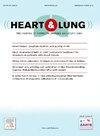心内直视手术后患者对疾病进展的恐惧:一项横断面研究
IF 2.6
4区 医学
Q2 CARDIAC & CARDIOVASCULAR SYSTEMS
引用次数: 0
摘要
背景:疾病进展恐惧(FoP)是心内直视手术(OHS)后患者出现的一个新问题,但关于这一现象的数据很少,需要进一步调查。目的探讨OHS术后FoP的现状,并探讨与FoP相关的潜在因素。方法采用方便抽样的横断面设计,对2024年3月至2025年4月在国内某三级医院心血管外科就诊的210例OHS患者采用人口学及临床特征问卷、进展恐惧简易问卷、医疗应对方式问卷、社会支持评定量表、疾病简易感知问卷和医院焦虑抑郁量表。数据分析采用相关分析、单变量分析和多元线性回归。结果FoP平均评分为34.55±6.34分,94例(44.76%)患者临床上FoP水平异常(评分≥34)。多元线性回归分析结果显示,年龄、文化程度、心血管疾病家族史、疾病发作次数、术后并发症、焦虑和抑郁、应对方式(对抗和回避)、社会支持、疾病认知是影响FoP的因素,占总方差的75.20%。结论fop是OHS术后常见的并发症。有必要根据患者的具体因素制定专门的心理干预措施和量身定制的援助,以减少FoP。本文章由计算机程序翻译,如有差异,请以英文原文为准。
Fear of disease progression in patients after open-heart surgery: A cross-sectional study
Background
Fear of disease progression (FoP) is an emerging issue in patients after open-heart surgery (OHS), but data on this phenomenon are scarce and require further investigation.
Objectives
This study aims to explore the current status of FoP in patients after OHS and to detect potential factors associated with FoP.
Methods
A cross-sectional design with convenience sampling was conducted on 210 patients who experienced OHS in the Department of Cardiovascular Surgery of a tertiary hospital in China from March 2024 to April 2025 by the demographic and clinical characteristics questionnaire, the Fear of Progression Questionnaire-Short Form, the Medical Coping Modes Questionnaire, the Social Support Rating Scale, the Brief Illness Perception Questionnaire, and the Hospital Anxiety and Depression Scale. Data were analyzed by using correlation analysis, univariate analysis, and multiple linear regression.
Results
The average score of FoP was 34.55 ± 6.34, with 94 patients (44.76 %) having clinically abnormal FoP levels (score ≥ 34). The results of multiple linear regression analysis showed that age, educational level, family history of CVD, number of disease episodes, postoperative complications, anxiety and depression, coping modes (confrontation and avoidance), social support, illness perception were factors influencing FoP, accounting for 75.20 % of the total variance.
Conclusion
FoP is a commonly observed issue among patients after OHS. It is necessary to develop specialized psychological interventions and tailored assistance based on patient-specific factors to reduce FoP.
求助全文
通过发布文献求助,成功后即可免费获取论文全文。
去求助
来源期刊

Heart & Lung
医学-呼吸系统
CiteScore
4.60
自引率
3.60%
发文量
184
审稿时长
35 days
期刊介绍:
Heart & Lung: The Journal of Cardiopulmonary and Acute Care, the official publication of The American Association of Heart Failure Nurses, presents original, peer-reviewed articles on techniques, advances, investigations, and observations related to the care of patients with acute and critical illness and patients with chronic cardiac or pulmonary disorders.
The Journal''s acute care articles focus on the care of hospitalized patients, including those in the critical and acute care settings. Because most patients who are hospitalized in acute and critical care settings have chronic conditions, we are also interested in the chronically critically ill, the care of patients with chronic cardiopulmonary disorders, their rehabilitation, and disease prevention. The Journal''s heart failure articles focus on all aspects of the care of patients with this condition. Manuscripts that are relevant to populations across the human lifespan are welcome.
 求助内容:
求助内容: 应助结果提醒方式:
应助结果提醒方式:


